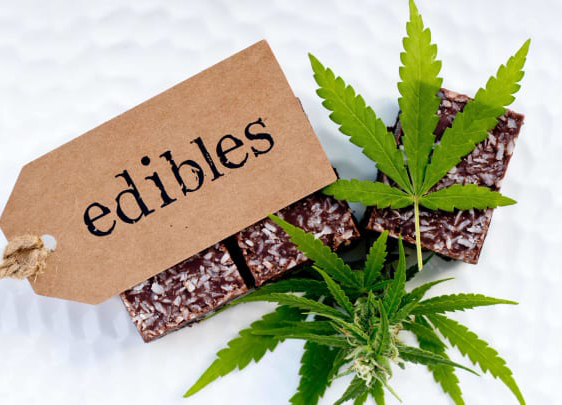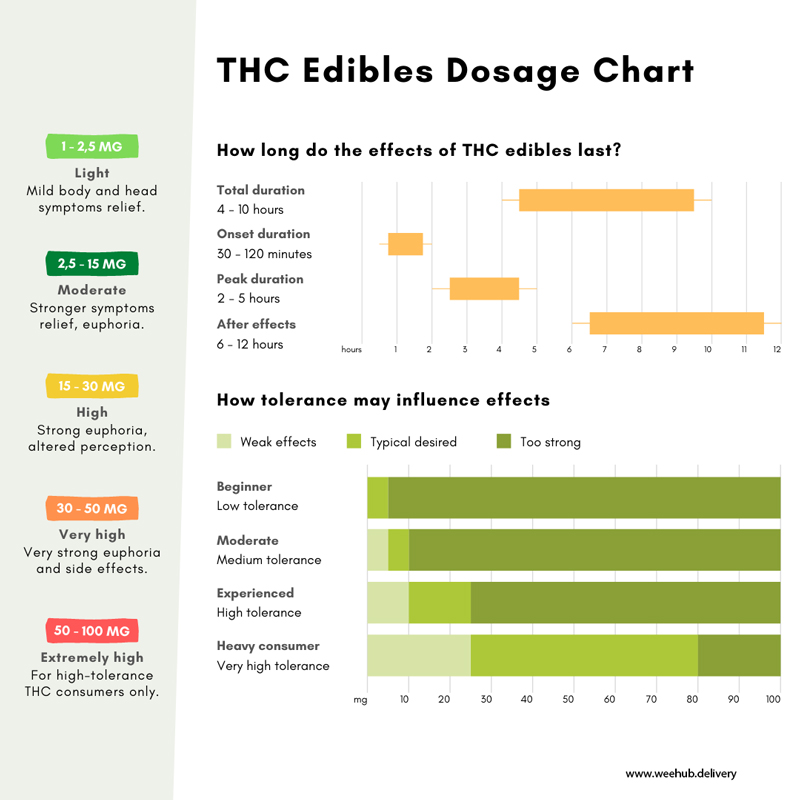EDIBLES 101

What are Cannabis Edibles?
It’s a food or beverage containing THC and other substances, commonly derived from marijuana flower, oil, or concentrates. Edibles, unlike smoking or vaping, have no detrimental effects on the respiratory system. They’re helpful for MMJ individuals who have respiratory or lung problems.
Edibles are very popular among those who are undergoing chemotherapy. It could provide them a much-needed hunger boost if they utilize the correct strain. The THC-infused substance can be consumed by eating or drinking it. There is now a wide variety of cannabis edibles available, including:
- Brownies
- Baked Goods
- Chocolate
- Candy / Gummies
- Drinks
- Popcorn
How Long Does a Cannabis Edible Take to Take Effect?
If you’re new to marijuana edibles, approach with caution. It’s a very different experience from smoking or vaping, which have immediate results. Edibles, on average, take 30 to 60 minutes to take effect. However, it may take up to 120 minutes for some people. In actuality, you won’t know unless you have had an edible.
THC gum, lozenges, and lollipops, for example, function faster since they are absorbed sublingually. Because chewable food like brownies, gummies, and cookies pass through the digestive system, they take longer.
After consuming a cannabinoid-infused consumable, the cannabinoids pass through the digestive system and reach the liver, where THC — the psychoactive chemical molecule responsible for cannabis’ intoxicating effect — is converted into 11-Hydroxy-THC. This metabolite has a higher psychedelic impact than THC and is more effective at bridging the blood-brain barrier. The liver metabolizes THC into 11-Hydroxy-THC, effects are compounded, and components generate a far more intense high than smoking, according to McGill University Associate Professor Dr. Mark A. Ware.
Factors that impact the onset time of marijuana edibles include:
- Gender
- Bodyweight
- Tolerance
- Diet
- Metabolism
When eating an edible, it’s easy to get eager and take a second dose just after the first. This process may have a number of negative consequences, which we will discuss later. If you’re new to edibles, wait up to 24 hours after your first dose before trying another.
Edible Dosage
Edibles take longer to take effect than other kinds of consumption, but they may be more strong. Despite their limited bioavailability, this is the case (absorption rate).
The pharmacokinetics of cannabis were studied in a 2005 article published in Pain Research & Management. THC has a bioavailability rate of between 4% and 12% when eaten orally, according to the study. They did point out, however, that the rate of THC absorption is considerably variable.
THC absorption may be boosted by combining cannabis edibles with lipids. This is why companies selling CBD and THC oil utilize ‘carrier’ oils like MCT.
Edibles are also measured differently than cannabis flower or concentrates in terms of potency. THC percentages are included in the latter selections, however edibles often list total THC amount in milligrams. However, most states that allow medical marijuana or recreational cannabis sales have restrictions on how potent edibles can be.
Many people prefer to chop or divide their edibles into smaller portions. A chocolate bar containing 100mg of THC, for example, might be divided into ten portions. Each one has 10 milligrams of THC. You know exactly how much cannabis you’re consuming if the product comes with third-party lab reports.
When it comes to dose, a beginner should stick to the 1-5mg range and wait until the next day to assess the effects. Increase by a maximum of 2.5mg if these side effects are minor. An intermediate cannabis user might take 5-15mg per dose, whereas a seasoned cannabis user might take 20mg or more.

What Is the Duration of the High from Cannabis Edibles?
THC in marijuana edibles is converted to 11-hydroxy-THC in the liver. Because this component is much more active than THC, edibles can have a much stronger effect than cannabis flowers. THC has a shorter half-life than 11-hydroxy-THC, and it usually has a sedative effect.
The duration of an edibles high is determined by a number of factors, including the product’s potency and dose. The length and intensity of the high are influenced by the same factors that influence the onset time. The ‘peak’ impact usually happens 1-2 hours after use. At this point, the exhilarating high is at its peak.
In some people, the high can continue up to eight hours, though this varies greatly. In 2017, a study published in the journal Drug and Alcohol Dependence discovered some interesting findings.
Are Cannabis Edibles Safe?
One popular misconception about edibles is that they are “safer” than marijuana that has been smoked or vaporized. While it is true that ingesting cannabis is beneficial for the lungs, there are some drawbacks to the habit.
The simplicity of use is potentially harmful in and of itself. It’s far easier to consume too much cannabis edible than it is to ingest too much marijuana flower. Here in California, for example, edibles can be purchased daily in quantities of up to 8000mg (8 Grams). That’s the equivalent of up to 2 ounce of ultra-high-potency cannabis flower.
Although there have been no proven reports of cannabis edibles overdose deaths, the potential side effects are serious and include:
- Anxiety and agitation
- Increased stress on the heart
- Nausea and vomiting
- Cognitive and motor impairment
- Delusions
- Psychosis
Cannabis Edibles Pros
- It’s easier on the lungs than smoking or vaporizing cannabis.
- THC content is prominently marked on edibles purchased from a licensed dispensary. As a result, they may be simple to dose.
- Edibles are a delicious way to consume marijuana.
- The market offers a wide range of products.
- When compared to smoking or vaporizing THC, the euphoric high lasts longer.
Cannabis Edibles Cons
- It takes longer to feel the benefits of marijuana than it does with other ways to consume.
- It’s simple to take too much THC through edibles, which can cause dangerous negative effects.
- For some people, the strength of edibles might be overwhelming.
- Low bioavailability.
Last Words on Cannabis Edibles
Marijuana edibles, as the name implies, are a form of the plant that may be eaten or drank. The chemicals pass via the digestive system and are processed by the liver after being ingested orally. THC forms 11-THC-hydroxy at this moment, which is a stronger molecule.
Edibles are a convenient, tasty, and quick way to consume marijuana. In certain circumstances, feeling intoxicated can take up to two hours. The high, on the other hand, is stronger and often lasts longer than with other forms of THC ingestion.
Cannabis edibles, in particular, are popular among MMJ patients, but they are not without risk. It’s simple to get too much THC from an edible, and the adverse effects might be minor to severe. When utilizing edibles, it’s important to start with a little dose and wait a long time for the effects to appear. Edibles can be a simple and helpful method to utilize cannabis if they are consumed responsibly.
